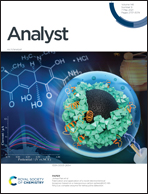Flexible thread-based electrochemical sensors for oxygen monitoring†
Abstract
Oxygen plays a key role in human physiology and is abnormally modulated in various disease pathologies making its in situ monitoring quite important. Most oxygen sensors are not able to measure oxygen levels deep inside the tissue or have mismatched electrode–tissue interfaces. In this study we developed a flexible thread-based oxygen sensor that combines the unique advantages of minimal invasiveness and superior flexibility offering the possibility for tissue integration. The sensor is featured by a simple and low-cost fabrication approach which allows for measuring the overall oxygen concentration either over a large surface area or locally at any spot in any three-dimensional environment with high spatial accuracy and high sensitivity. The sensor can sensitively detect dissolved oxygen levels within the physiological range of tissue oxygenation. The sensor's performance is insensitive to pH variation from 5.8 to 8.0. The sensor shows good repeatability and stability over a period of one week in phosphate buffered saline. In addition, the signal variation is less than 10% after hundreds of cycles of physical bending. Using a hydrogel-based tissue model the sensor has been shown to probe dissolved oxygen levels at different spatial locations inside a tissue-like environment.



 Please wait while we load your content...
Please wait while we load your content...